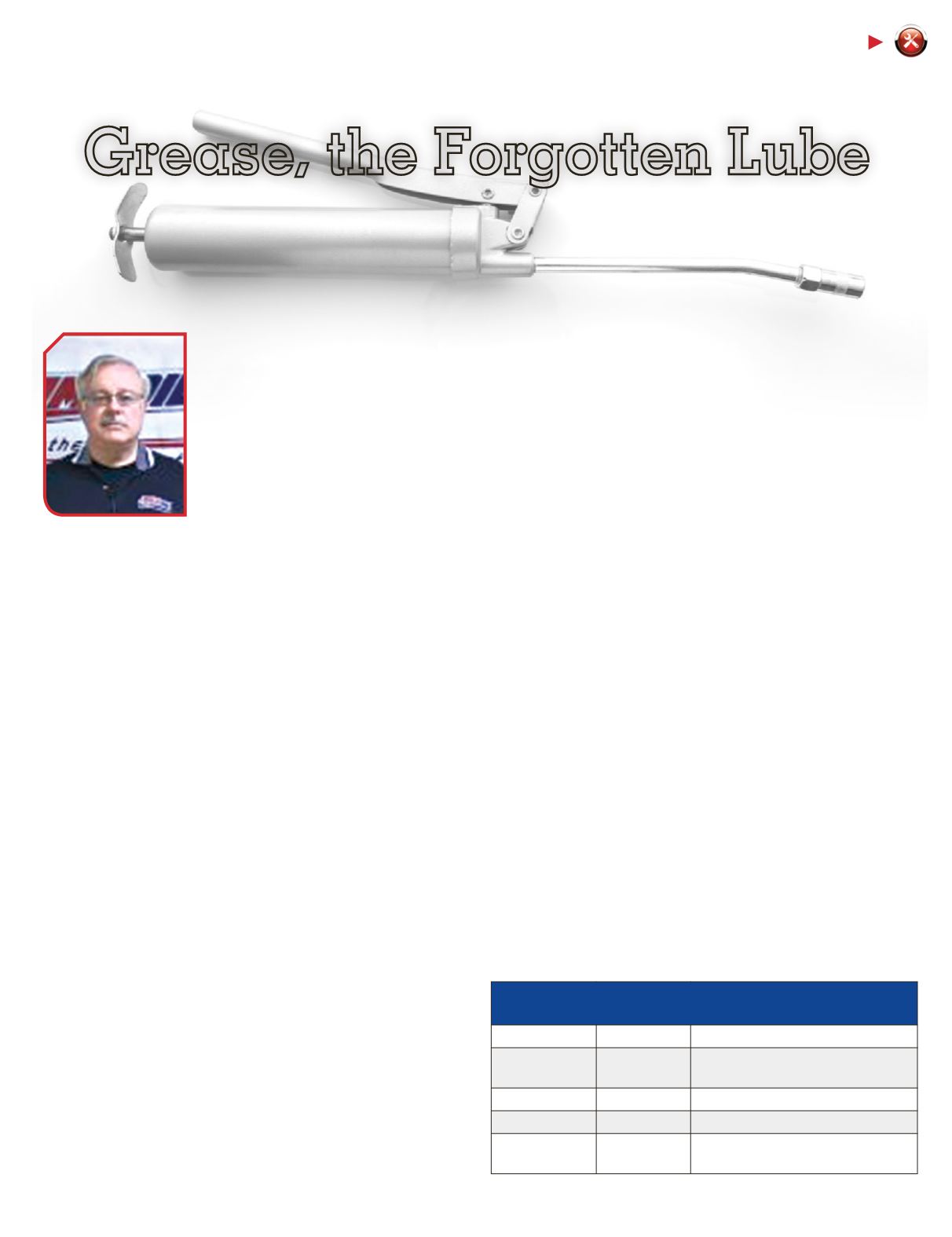
SUMMER 2015 | MARINE TECHNICIANTODAY
15
TECH TALK
I
n previous articles, we looked at the
role lubricants play in overcoming the
effects of friction. In this installment,
I want to examine one specialized type
of lubricant: grease. Looking at previous
civilizations, we can see that man has
tried several methods to provide basic
lubrication to load-bearing surfaces; axles
have presented one of the most challenging
applications. As far back as 1400 BC, mutton
fat and beef tallow were used on chariot
axles to reduce friction in order to allow for more speed and to slow
down wear. One can only imagine the pressure on the maintenance men
to make the chariot go faster and to avoid axles catching on fire from
the continuous friction. While there is evidence of lime being added to
these fats in order to make their lubricating properties last longer, few
other improvements to the composition of grease are known to have
been used until we reach the magic year of 1859.
What happened in 1859? Colonel Drake drilled the first ever oil well
in Pennsylvania; since then, the world has not been the same. In
petroleum oil, man found a lubricant that could be manipulated in a
variety of ways to produce greases much superior to the lubricants
that preceded them. In turn, more advanced and effective greases have
been produced in recent decades with the advent of synthetic greases.
The word grease is derived from the Latin word
Crassus
meaning
fat. We can see where the name came from (mutton fat, beef tallow);
however, grease, for modern purposes, is not to be construed as fat. The
American Society for Testing Materials (ASTM) defined grease in 1916
as: A solid to semi-fluid product of dispersion of a thickening agent in
a liquid lubricant. In plain English, this means a lubricant composed of
lubricating fluids (oils), thickened by mixing chemicals to produce a
semi-fluid to semi-solid consistency.
Now that we know a little of the history of grease and how grease is
defined in modern lubrication; when, where and why is grease used?
While lubricating oils are able to lubricate any friction-causing situation,
greases offer unique characteristics that are well suited for:
• Situations requiring less dripping or spattering of lubricant
• Hard to lubricate bearings or joints where reducing frequency of
lubrication is needed
• In dirty, dusty or hazardous environments where additional sealing
is needed to prevent lubricant contamination.
• Where the bearings or joints will be submerged or sprayed with water.
• For intermittent operation. Oil drains away from critical bearings
when the equipment is stopped, but grease stays in place.
GREASE COMPOSITION
Greases are made from oil and thickeners (sometimes called soaps).
The process is simple, but the details are fairly complex. The lubricating
oil can be petroleum or synthetic and can vary in viscosity. Additionally,
anti-wear and extreme pressure additives can be added to formulate
greases for specific applications, such as, high speed bearings, very
cold or very hot conditions, open gears, extreme loads or high moisture
conditions, to name a few. Oil and thickeners can be combined to offer
greater temperature ranges and resistance to moisture. Thickeners can
be combined or formulated with additional chemicals to produce more
complex thickeners for specific applications.
Greases will vary in thickness depending on the amount and type of
thickeners used as well as the viscosity of the lubricating oil used.
The National Lubricating Grease Institute (NLGI) is the regulating body
that establishes specific ratings for greases. Greases are rated on a
hardness scale from 000 to 6; where 000 is a thick liquid, like pudding,
and 6 is a block, similar to hard clay. Today, 000 grease is used as a
replacement for gear lubes in bearings and differentials and number 6
grease is used where a rubbing action is needed to produce a light film
on the surface to be lubricated. Wheel bearings and chassis greases
used in auto, truck and trailer applications are usually NLGI #2. In very
cold climates NLGI #1 grease is preferred because the grease will
thicken in response to the temperatures. Synthetic greases thickened
with appropriate compounds are functional over a wide temperature
range, from minus 50ºF to 500ºF; petroleum greases are generally
limited to 0°F to 300°F.
By DanWatson
Grease, the Forgotten Lube
Table One – NLGI Classification System for Automotive Greases
Application
NLGI Service
Classifications Service Limitations
Chassis
LA
Mild duty, frequent re-lubrication
Chassis
LB
Infrequent re-lubrication,
high loads, water exposure
Wheel Bearings GA
Mild duty
Wheel Bearings GB
Moderate duty, typical of most vehicles
Wheel Bearings GC
Severe duty, high temperatures,
frequent stop and go service


